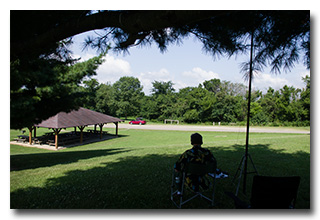
by William Eric McFadden
Support-Your-Parks Summer 2019 RATpedition, Day 1
From the park's website:
-
Great Seal State Park is located just north of the town of Chillicothe and dedicated to the wilderness spirit of Ohio. The history of the Shawnee nation and Ohio's early statehood is centered in these rugged hills. Challenging trails through the 1,862-acre park take visitors to scenic vistas of distant ridgetops and the Scioto Valley below. These very hills are depicted on the Great Seal of the State of Ohio, from which the park gets its name. First depicted in 1803, the seal was often reconfigured until the present image was sanctioned by the Ohio General Assemble in 1967 and modified in 1996. In 1803, the law prescribed the sheaf of wheat to represent Ohio's agricultural roots and the bundle of seventeen arrows to symbolize Ohio's place as the seventeenth state in the Union. The range of hills seen in the background of the seal, include Mount Logan, as viewed from Thomas Worthington's estate, Adena, now a state memorial.
Pictures
- The park sign
- Eric operating; photo by Miles McFadden
Description
On Saturday, July 20, 2019, on the first day of the two-day Support Your Parks Summer 2019 event, two members of the Southeast Ohio Radio Adventure Team undertook an aggressive operation to activate five POTA units in southern Ohio. Eric McFadden, WD8RIF, and Miles McFadden, KD8KNC, drove over 150 miles and were on the road for eleven hours to visit and activate Great Seal State Park (K-1954), Hopewell Culture National Historical Park (K-0737), Scioto Trail State Forest (K-5448), Scioto Trail State Park (K-1990), and Lake White State Park (K-1971) as part of the Parks on the Air (POTA; link) program.
The first stop was Great Seal State Park, K-1954.
 Eric and Miles arrived at the Scenic Overlook camping area at Great Seal State Park at about
1345 UTC and, after a break to visit the facilities and after spending a few minutes exploring the
options presented by the location, they chose to set up Eric's station in the shade of a large tree at
the top of the hill in the center of the area. Eric and Miles quickly deployed the 28½' end-fed vertical
supported on an MFJ-1910 33' fiberglass mast and set up the KX3 on Eric's folding camping chair.
Eric was on the air by 1419 UTC.
Eric and Miles arrived at the Scenic Overlook camping area at Great Seal State Park at about
1345 UTC and, after a break to visit the facilities and after spending a few minutes exploring the
options presented by the location, they chose to set up Eric's station in the shade of a large tree at
the top of the hill in the center of the area. Eric and Miles quickly deployed the 28½' end-fed vertical
supported on an MFJ-1910 33' fiberglass mast and set up the KX3 on Eric's folding camping chair.
Eric was on the air by 1419 UTC.
Eric began operations on 80m for a QSO at 1422 UTC with his friend and fellow SEORAT-member, K8RAT. Not expecting much additional activity on 80m at that time of day, Eric switched to 40m to continue operations.
To test the POTA Spots website, Eric began operations on 40m with several long CQ calls formatted precisely as specified by instructions on the POTA FAQ (link), "CQ POTA WD8RIF WD8RIF K1954 K", sent by the KX3's internal memory keyer at 18wpm. After several minutes without a spot appearing, Eric asked Miles to post a spot to pota.us using his smartphone.
Almost as soon as the first spot appeared, QSOs began filling up the log. Eric's first QSO on 40m came at 1429 UTC with N2ESE, a station Eric has come to expect at his POTA activations. Half an hour later Eric made his 19th QSO on 40m with W2LJ.
Switching to 20m, Eric's first QSO there came at 1502 UTC with W6LEN. Given his experiences at other recent POTA activations, Eric hadn't expected much activity on 20m but subsequent QSOs came so quickly Eric was even able to log them in real time—he could only take notes on his CW copy-paper and hope he could read his writing later. In the unexpected rush of activity, Eric made sixteen QSOs in only fifteen minutes, with his 36th and final QSO coming at 1517 UTC with AA2VG.
Eric and Miles tore down the station, packed the car, and began the very short drive to the second of the five parks, Hopewell Culture National Historical Park, K-0737.
Eric's log for this operation contained many callsigns that Eric was to see throughout the day as he completed activations at five locations: K8RAT, N2ESE, NE4TN, W9AV, WT4U, WA9LEY, KB9KC, W0ZAP, W1WBB, K4CAE, N4BC, W5GAI, W0YJT, plus others.
All Eric's QSOs were CW and were made at the 5-watt level. Miles didn't operate but did much of the expedition photography and helped with set-up and tear-down, spotting, and navigation.
Eric also submitted his log to the World Wide Flora and Fauna in Amateur Radio (WWFF; link) program although he didn't make enough QSOs to to achieve a valid activation within the program which requires 44 QSOs be made. However, the WWFF program allows these 44 QSOs be made over any number of visits so a valid activation within WWFF is still possible if subsequent visits to the park are made.
(return)